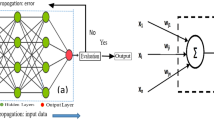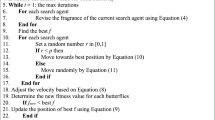Abstract
Purpose
This work designs a procedure for structural damage assessment in beams under moving loads. The proposal is based on the respective alterations of hybrid vibrational factors with respect to the structural changes, whereby matching them for accurate predictions. These hybrid factors are extracted from the vibrational responses and then are employed for an artificial neural network (ANN) to assess the structural condition.
Methods
An experiment is deployed to generate a databank for evaluation as well as ANN training. The maximal overlap discrete wavelet transform (MODWT) and the fast Fourier transform (FFT) are incorporated to split original signals into several power bands, which helps to exploit characteristics of individual vibrational modes: centroids and comparative powers of allocated spectra. The extracted hybrid factors are then fed into an ANN to predict the damage condition of the beam. The training process of this ANN uses a databank of extracted features from measured signals.
Results
The paper successfully finds out the damage-sensitive feature through signal processing. Alternatively, the implemented experiment provides a rich databank for the ANN training, and the training performance reaches a high accuracy. Moreover, the testing results reveal the superior generalization of the ANN because of automatic predictions with high precision. This proves the contribution of the study that the exploited features are proper for structural assessment, and the trained ANN learns the correlation of vibration features and structural state well.
Conclusions
The automation and effectiveness of the proposed approach are endorsed, which has high applicability and accuracy for damage assessment in beams. The proposed method is mainly devoted to identifying, quantifying, and localizing damage.




















Similar content being viewed by others
Data availability
Data should be available via correspondence upon reasonable requests.
References
Knitter-Piątkowska A, Dobrzycki A (2020) Application of wavelet transform to damage identification in the steel structure elements. Appl Sci. https://doi.org/10.3390/app10228198
Cao J, Zhou Z, Liu Y (2022) Damage localization for prefabricated bridges group using the area-ratio of the strain time-history curve. Measurement 198:111172
Yan A-M, Golinval J-C (2006) Null subspace-based damage detection of structures using vibration measurements. Mech Syst Signal Process 20(3):611–626
Zhang K, Ma C, Xu Y, Chen P, Du J (2021) Feature extraction method based on adaptive and concise empirical wavelet transform and its applications in bearing fault diagnosis. Measurement 172:108976
Ding X, Li Q, Lin L, He Q, Shao Y (2019) Fast time-frequency manifold learning and its reconstruction for transient feature extraction in rotating machinery fault diagnosis. Measurement 141:380–395
Doebling SW, Farrar CR, Prime MB (1998) A summary review of vibration-based damage identification methods. Shock and vibration digest 30(2):91–105
Duhamel P, Vetterli M (1990) Fast Fourier transforms: a tutorial review and a state of the art. Signal Process 19(4):259–299
Cawley P, Adams RD (1979) The location of defects in structures from measurements of natural frequencies. J Strain Anal Eng Des 14(2):49–57
Ngo NK, Nguyen TQ, Vu TV, Nguyen-Xuan H (2020) An fast Fourier transform–based correlation coefficient approach for structural damage diagnosis. Structural Health Monitoring:1475921720949561
Zhang F-L, Kim C-W, Goi Y (2021) Efficient Bayesian FFT method for damage detection using ambient vibration data with consideration of uncertainty. Struct Control Health Monit 28(2):e2659
Erazo K, Sen D, Nagarajaiah S, Sun L (2019) Vibration-based structural health monitoring under changing environmental conditions using Kalman filtering. Mech Syst Signal Process 117:1–15
Pham-Bao T, Nguyen-Nhat T, Ngo-Kieu N (2022) A novel approach to investigate the mechanical properties of the material for bridge health monitoring using convolutional neural network. Struct Infrastruct Eng. https://doi.org/10.1080/15732479.2022.2127792
Ngo-Kieu N, Nguyen-Da T, Pham-Bao T, Nguyen-Nhat T, Nguyen-Xuan H (2021) Deep learning-based signal processing for evaluating energy dispersal in bridge structures. J Zhejiang Univ-SCI A 22(8):672–680
Nguyen TD, Nguyen TQ, Nhat TN, Nguyen-Xuan H, Ngo NK (2020) A novel approach based on viscoelastic parameters for bridge health monitoring: a case study of Saigon bridge in Ho Chi Minh City – Vietnam. Mech Syst Signal Process 141:106728
Gurley K, Kareem A (1999) Applications of wavelet transforms in earthquake, wind and ocean engineering. Eng Struct 21(2):149–167
Mallat S (1999) A wavelet tour of signal processing. Elsevier, San Diego
Epp T, Cha Y-J (2017) Air-coupled impact-echo damage detection in reinforced concrete using wavelet transforms. Smart Mater Struct 26(2):025018
Zhu XQ, Law SS (2006) Wavelet-based crack identification of bridge beam from operational deflection time history. Int J Solids Struct 43(7):2299–2317
Cantero D, Basu B (2015) Railway infrastructure damage detection using wavelet transformed acceleration response of traversing vehicle. Struct Control Health Monit 22(1):62–70
Hester D, González A (2012) A wavelet-based damage detection algorithm based on bridge acceleration response to a vehicle. Mech Syst Signal Process 28:145–166
Beale C, Niezrecki C, Inalpolat M (2020) An adaptive wavelet packet denoising algorithm for enhanced active acoustic damage detection from wind turbine blades. Mech Syst Signal Process 142:106754
Cha Y-J, Wang Z (2017) Unsupervised novelty detection–based structural damage localization using a density peaks-based fast clustering algorithm. Struct Health Monit 17(2):313–324
Liu Z, Zhang L, Carrasco J (2020) Vibration analysis for large-scale wind turbine blade bearing fault detection with an empirical wavelet thresholding method. Renewable Energy 146:99–110
Pawlak Z (1922) Knitter-Piątkowska A (2018) Influence of the wavelet order on proper damage location in plate structures. AIP Conf Proc 1:130006
Barros J, Diego RI (2008) Analysis of harmonics in power systems using the Wavelet-Packet transform. IEEE Trans Instrum Meas 57(1):63–69
Costa FB, Driesen J (2013) Assessment of voltage sag indices based on scaling and wavelet coefficient energy analysis. IEEE Trans Pow Deliv 28(1):336–346
Paramasivam S, Pl SA, Sathyamoorthi P (2022) Maximal overlap discrete wavelet transform-based power trace alignment algorithm against random delay countermeasure. ETRI J 44(3):512–523
**ao F, Lu T, Wu M, Ai Q (2020) Maximal overlap discrete wavelet transform and deep learning for robust denoising and detection of power quality disturbance. IET Gener Transm Distrib 14(1):140–147
Mansi SK, Vanraj DSS (2021) MODWT and VMD based intelligent gearbox early stage fault detection approach. J Fail Anal Prev 21(5):1821–1837
Wang Z, Cha Y-J (2022) Unsupervised machine and deep learning methods for structural damage detection: a comparative study. Eng Rep. https://doi.org/10.1002/eng2.12551
Tran-Ngoc H et al (2022) Damage assessment in structures using artificial neural network working and a hybrid stochastic optimization. Sci Rep 12(1):4958
Tuan Hoang A et al (2021) A review on application of artificial neural network (ANN) for performance and emission characteristics of diesel engine fueled with biodiesel-based fuels. Sustainable Energy Technol Assess 47:101416
Movsessian A, García Cava D, Tcherniak D (2021) An artificial neural network methodology for damage detection: demonstration on an operating wind turbine blade. Mech Syst Signal Process 159:107766
Nick H, Aziminejad A, Hamid Hosseini M, Laknejadi K (2021) Damage identification in steel girder bridges using modal strain energy-based damage index method and artificial neural network. Eng Fail Anal 119:105010
Rodrigues DVQ, Zuo D, Li C (2022) A MODWT-based algorithm for the identification and removal of jumps/short-term distortions in displacement measurements used for structural health monitoring. IoT 3(1):60–72
Boashash B (2015) Time-frequency signal analysis and processing: a comprehensive reference. Academic press, London
Newland DE (2005) An introduction to random vibrations, spectral & wavelet analysis. Dover Publications, New York
Bilello C, Bergman LA (2004) Vibration of damaged beams under a moving mass: theory and experimental validation. J Sound Vib 274(3):567–582
Pham-Bao T, Ngo-Kieu N, Vuong-Cong L, Nguyen-Nhat T (2022) Energy dissipation-based material deterioration assessment using random decrement technique and convolutional neural network: A case study of Saigon bridge in Ho Chi Minh City. Vietnam Struct Control Health Monitoring 29(7):e2956
François S et al (2021) Stabil: an educational Matlab toolbox for static and dynamic structural analysis. Comput Appl Eng Educ 29(5):1372–1389
Cao MS, Sha GG, Gao YF, Ostachowicz W (2017) Structural damage identification using dam**: a compendium of uses and features. Smart Mater Struct 26(4):043001
Curadelli RO, Riera JD, Ambrosini D, Amani MG (2008) Damage detection by means of structural dam** identification. Eng Struct 30(12):3497–3504
Hagan MT, Menhaj MB (1994) Training feedforward networks with the Marquardt algorithm. IEEE Trans Neural Networks 5(6):989–993
Acknowledgements
We acknowledge Ho Chi Minh City University of Technology (HCMUT), VNU-HCM, for supporting this study.
Funding
This research is funded by Vietnam National University Ho Chi Minh City (VNU-HCM) under grant number C2021-20-05.
Author information
Authors and Affiliations
Corresponding author
Ethics declarations
Conflict of interest
The authors declared no potential conflicts of interest with respect to the research, authorship, and/or publication of this article.
Additional information
Publisher's Note
Springer Nature remains neutral with regard to jurisdictional claims in published maps and institutional affiliations.
Rights and permissions
Springer Nature or its licensor (e.g. a society or other partner) holds exclusive rights to this article under a publishing agreement with the author(s) or other rightsholder(s); author self-archiving of the accepted manuscript version of this article is solely governed by the terms of such publishing agreement and applicable law.
About this article
Cite this article
Nguyen-Nhat, T., Vuong-Cong, L., Le-Ngoc, V. et al. Inspecting Spectral Centroid and Relative Power of Allocated Spectra Using Artificial Neural Network for Damage Diagnosis in Beam Structures Under Moving Loads. J. Vib. Eng. Technol. 12, 4617–4635 (2024). https://doi.org/10.1007/s42417-023-01140-y
Received:
Revised:
Accepted:
Published:
Issue Date:
DOI: https://doi.org/10.1007/s42417-023-01140-y




